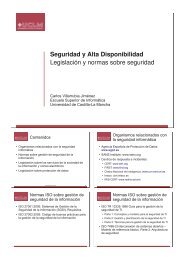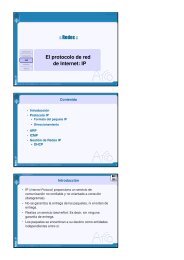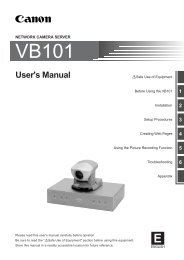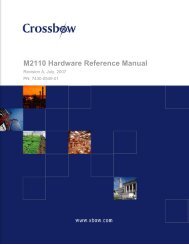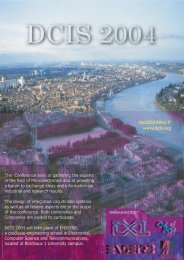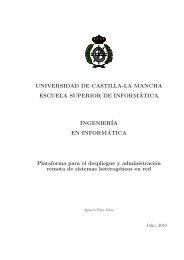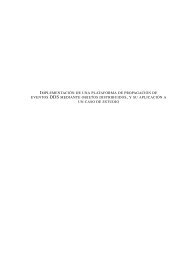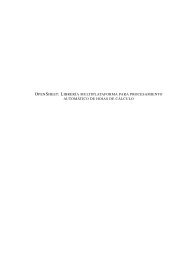Pensar en C++ (Volumen 1) - Grupo ARCO
Pensar en C++ (Volumen 1) - Grupo ARCO
Pensar en C++ (Volumen 1) - Grupo ARCO
Create successful ePaper yourself
Turn your PDF publications into a flip-book with our unique Google optimized e-Paper software.
✐<br />
✐<br />
✐<br />
“Volum<strong>en</strong>1” — 2012/1/12 — 13:52 — page XXXIII — #33<br />
✐<br />
Estándares del l<strong>en</strong>guaje<br />
the theory of liability, arising out of the use of<br />
or inability to use software, ev<strong>en</strong> if Bruce Eckel<br />
and the publisher have be<strong>en</strong> advised of the<br />
possibility of such damages. Should the software<br />
prove defective, you assume the cost of all<br />
necessary servicing, repair, or correction. If you<br />
think you’ve found an error, please submit the<br />
correction using the form you will find at<br />
www.BruceEckel.com. (Please use the same<br />
form for non-code errors found in the book.)<br />
Se puede usar el código <strong>en</strong> proyectos y clases siempre y cuando se mant<strong>en</strong>ga la<br />
nota de copyright.<br />
Estándares del l<strong>en</strong>guaje<br />
Durante todo el libro, cuando se haga refer<strong>en</strong>cia al estándar de C ISO, g<strong>en</strong>eralm<strong>en</strong>te<br />
se dirá «C». Sólo si se necesita distinguir <strong>en</strong>tre C estándar y otros más viejos,<br />
versiones previas al estándar de C, se hará una distinción.<br />
Cuando se escribió este libro, el Comité de Estándares de <strong>C++</strong> ya había terminado<br />
de trabajar <strong>en</strong> el l<strong>en</strong>guaje. Por eso, se usará el término <strong>C++</strong> Estándar para referirse al<br />
l<strong>en</strong>guaje estandarizado. Si se hace refer<strong>en</strong>cia simplem<strong>en</strong>te a <strong>C++</strong>, debería asumir que<br />
se quiere decir «<strong>C++</strong> Estándar».<br />
Hay alguna confusión sobre el nombre real del Comité de Estándares de <strong>C++</strong> y el<br />
nombre del estándar mismo. Steve Clamage, el presid<strong>en</strong>te del comité, clarificó esto:<br />
Hay dos comités de estandarización de <strong>C++</strong>: El comité NCITS (antiguam<strong>en</strong>te<br />
X3) J16 y el comité ISO JTC1/SC22/WG14. ANSI alquila NCITS<br />
para crear comités técnicos para desarrollar estándares nacionales americanos.<br />
J16 fue alquilado <strong>en</strong> 1989 para crear un estándar americano para <strong>C++</strong>.<br />
Por el año 1991 se alquiló WG14 para crear un estándar internacional.<br />
El proyecto J16 se convirtió <strong>en</strong> un proyecto «Tipo I» (Internacional) y se<br />
subordinó al esfuerzo de estandarización de ISO.<br />
Los dos comités se <strong>en</strong>contraban al mismo tiempo <strong>en</strong> el mismo sitio, y<br />
el voto de J16 constituye el voto americano con WG14. WG14 delega el<br />
trabajo técnico a J16. WG14 vota por el trabajo técnico de J16.<br />
El estándar de <strong>C++</strong> fue creado originalm<strong>en</strong>te como un estándar ISO. AN-<br />
SI votó más tarde (como recom<strong>en</strong>daba J16) para adoptar el estándar de<br />
<strong>C++</strong> ISO como el estándar americano para <strong>C++</strong>.<br />
Por eso, «ISO» es la forma correcta de referirse al Estándar <strong>C++</strong>.<br />
Soporte del l<strong>en</strong>guaje<br />
Puede que su compilador no disponga de todas las características discutidas <strong>en</strong><br />
este libro, especialm<strong>en</strong>te si no ti<strong>en</strong>e la versión más rec<strong>en</strong>te del compilador. Imple-<br />
XXXIII<br />
✐<br />
✐<br />
✐<br />
✐



